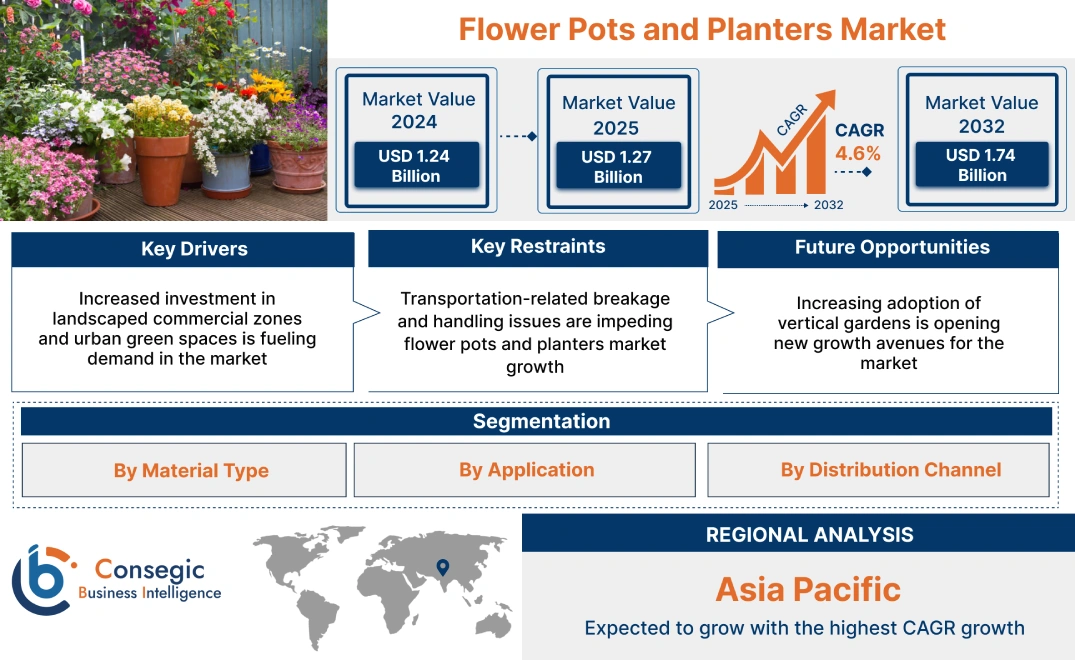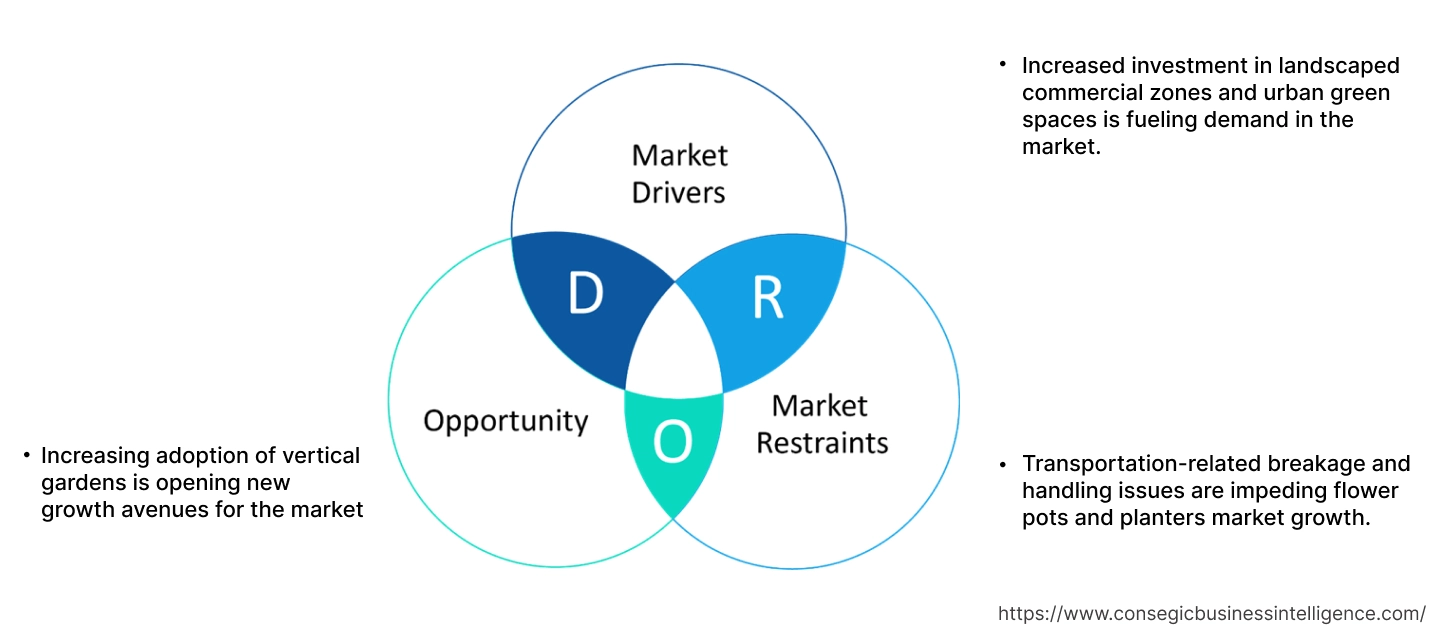Flower Pots and Planters Market Size:
Flower Pots and Planters Market size is estimated to reach over USD 1.74 Billion by 2032 from a value of USD 1.24 Billion in 2024 and is projected to grow by USD 1.27 Billion in 2025, growing at a CAGR of 4.4% from 2025 to 2032.
Flower Pots and Planters Market Scope & Overview:
Flower pots and planters are containers specifically designed to support the growth, display, and management of plants in indoor and outdoor environments. They come in a wide range of materials including ceramic, clay, plastic, concrete, fiberglass, and metal, each offering different levels of durability, weight, and aesthetic appeal depending on the setting and plant type.
These products are available in various shapes, dimensions, and designs to accommodate different types of plants, root systems, and decorative needs. Some models include built-in drainage holes, self-watering systems, or modular stacking features to enhance plant health and simplify maintenance. Planters can be designed for floor-standing, hanging, wall-mounted, or railing-mounted applications, making them versatile for use in homes, offices, commercial spaces, and public landscapes.
End-users include residential gardeners, landscape architects, commercial developers, and municipal authorities looking to organize, beautify, or manage plant installations across different environments. Flower pots and planters serve both functional and decorative purposes, supporting plant vitality while complementing the design of the surrounding space.
Key Drivers:
Increased investment in landscaped commercial zones and urban green spaces is fueling demand in the market.
Proliferation of urban spaces has boosted the expansion for creating green spaces in environments such as, parks, plazas, shopping malls, and corporate campuses. These spaces are designed to improve the aesthetic appeal of public areas while enhancing the well-being of visitors and workers. Large, durable flower pots and planters are essential in these environments, offering both function and style. The need for varied shapes, ranging from large, statement planters to smaller decorative pots, is increasing. Additionally, many commercial spaces are opting for customized planters to align with the design theme of the area.
- For instance, in February 2023, Natural England introduced the Green Infrastructure Framework (GIF), a comprehensive initiative aimed at enhancing urban environments across England by integrating nature into city planning and development. By embedding nature into urban settings through parks, green roofs, and tree-lined streets, the GIF aims to support biodiversity, mitigate climate change impacts, and improve public health and well-being.
As the importance of green spaces grows in urban planning, the requirement for both standard and custom planters for commercial landscaping projects is expected to continue rising, significantly propelling market progress.
Key Restraints:
Transportation-related breakage and handling issues are impeding flower pots and planters market growth.
Flower pots, particularly those made of delicate materials like ceramics or glass, are prone to breakage during transit. Fragile products require extra care during packaging and handling, which increases shipping costs and adds complexity to the supply chain. The risk of damage during delivery can lead to customer dissatisfaction and higher return rates, especially when dealing with online retail. For businesses, this damage not only increases costs but also reduces the overall profitability of flower pot sales. The need for special packaging and protective materials, such as foam inserts and bubble wrap, increases the cost of logistics. Moreover, the lack of proper handling during delivery can lead to a decrease in customer satisfaction and brand reputation. This fragility issue limits the broader adoption of flower pots in regions where shipping is a critical factor, affecting market growth.
Future Opportunities :
Increasing adoption of vertical gardens is opening new growth avenues for the market.
Urbanization is reducing available space for traditional gardening, prompting a shift toward vertical gardening as a practical alternative and boosting need for specialized flower pots and planters designed for compact, vertical setups. Urban dwellers, particularly those in apartments or small homes, are adopting vertical gardening techniques to maximize space for growing plants, herbs, and even vegetables. Wall-mounted planters, modular systems, and vertical garden frames are in high demand, as they enable people to grow plants in confined spaces while enhancing their surroundings. This shift is especially popular among environmentally conscious consumers looking to grow their own food in urban settings. Flower pots designed for vertical farming applications are being specifically engineered to offer easy installation, efficient water management, and optimal plant growth.
- For instance, in October 2024, Click & Grow announced the partnership with Ermonix, a U.S.-based indoor gardening brand, to expand its range of indoor garden offerings. This collaboration integrates Click & Grow's smart plant pod technology with Ermonix's distinctive designs, including the Hydrovase a sleek, minimalist indoor gardening system designed for effortless plant cultivation. The alliance aims to broaden the appeal of indoor gardening by offering more vertical and space-efficient solutions, catering to urban dwellers and those with limited space.
As vertical gardening continues to gain momentum, manufacturers who focus on creating functional, space-efficient products for urban farming will benefit from this growing market, contributing to the expansion of the global flower pots and planters market opportunities.
Flower Pots and Planters Market Segmental Analysis :
By Material Type:
Based on Material Type, the market is segmented into Plastic, Ceramic, Metal, Concrete, and others.
The Plastic segment holds the largest revenue of the overall Flower Pots and Planters Market share of 45.4% in the year 2024.
- Plastic pots and planters dominate the market due to their lightweight, affordability, and durability, making them accessible to a broad range of consumers.
- These planters are widely used in residential, commercial, and institutional settings for both indoor and outdoor gardening.
- Plastic planters are easy to transport, handle, and mass-produce, making them a preferred choice for high-volume sales through retail chains and online platforms.
- For instance, East Jordan Plastics is a leading U.S.-based manufacturer specializing in plant pots, planters, trays, and flats primarily for the horticulture industry. East Jordan Plastics focuses on producing containers made with up to 100% recycled plastic, demonstrating a deep commitment to environmental stewardship and circular manufacturing practices. Their wide product range includes nursery pots, shuttle pots, hanging baskets, and propagation trays designed to optimize growing space and transportation efficiency.
- According to the flower pots and planters market analysis, due to their cost-effectiveness and mass-market appeal, plastic contributes to the largest market share in material segment, significantly fuels the market growth.
The Ceramic segment is expected to grow at the fastest CAGR during the forecast period.
- Ceramic pots and planters are increasingly favored for their premium appearance, moisture retention properties, and traditional appeal.
- Need for ceramic planters is growing in urban landscaping, luxury residential projects, and boutique hospitality environments.
- The growing shift towards indoor gardening and stylish home décor is boosting the popularity of ceramic planters, particularly in developed markets.
- The rising trend for aesthetically pleasing and functional solutions have substantially driven the flower pots and planters market demand.
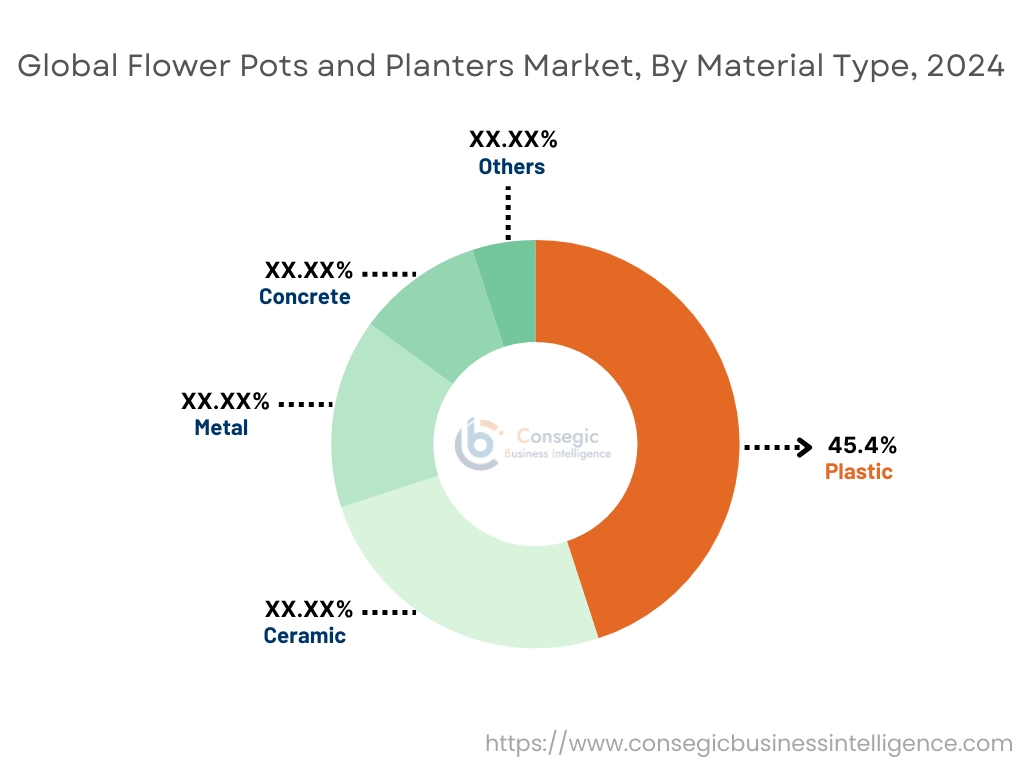
By Application:
Based on Application, the market is categorized into Residential, Commercial, and Industrial.
The Residential segment holds the largest revenue share of the overall Flower Pots and Planters Market in the year 2024.
- Residential users dominate the market, driven by increasing interest in home gardening, balcony gardens, and decorative indoor plants.
- Demand for stylish, low-maintenance planters that complement home interiors is rising, fueled by the shift in home renovation and do-it-yourself (DIY) gardening.
- Online retail platforms are expanding planter offerings targeted at homeowners looking for easy-to-use, attractive planting solutions.
- Thus, the high demand of residential gardening across urban and suburban settings, significantly drives the flower pots and planters market trends.
The Commercial segment is expected to grow at the fastest CAGR during the forecast period.
- The commercial sector, including hotels, corporate offices, retail complexes, and educational institutions is increasingly adopting green decor for brand enhancement and employee wellness.
- Landscape architects and interior designers are specifying high-quality, sustainable planters to meet environmental design standards such as LEED certification.
- Requirement for smart self-watering and modular planters is rising in commercial spaces focused on maintenance efficiency and eco-friendliness.
- According to the market analysis, the shifting trend towards sustainability and aesthetic enhancement is significantly fueling the global flower pots and planters market expansion.
By Distribution Channel:
Based on Distribution Channel, the market is segmented into Online Retail and Offline Retail.
The Offline Retail segment holds the largest revenue share of the overall Flower Pots and Planters Market in the year 2024.
- Offline retail, including garden centers, home improvement stores, supermarkets, and specialty decor shops has historically been the dominant channel for flower pots and planters.
- Physical stores allow customers to see, touch, and assess the dimensions, color, and quality of pots and planters before purchasing, enhancing consumer confidence.
- Major retailers and home improvement chains stock extensive collections, often merchandising products seasonally to maximize foot traffic during peak gardening periods.
- Thus, the well-established consumer behavior patterns and the tangible evaluation advantage, the offline retail segment contributes to the largest market share, significantly drives the flower pots and planters market trends.
The Online Retail segment is expected to grow at the fastest CAGR during the forecast period.
- Online retail platforms, including dedicated gardening websites, lifestyle e-commerce sites, and general online marketplaces, are experiencing significant progress.
- E-commerce offers consumers broader product variety, comparison options, customization features, and doorstep delivery, catering to the convenience-focused buyer.
- Virtual showrooms, augmented reality previews, and subscription models are enhancing customer experiences and encouraging higher-value purchases online.
- With rising consumer preference for convenience, expanded product assortment, and competitive pricing, the online retail segment is projected to grow, significantly fueling the global flower pots and planters market opportunities.
Regional Analysis:
The regions covered are North America, Europe, Asia Pacific, Middle East and Africa, and Latin America.
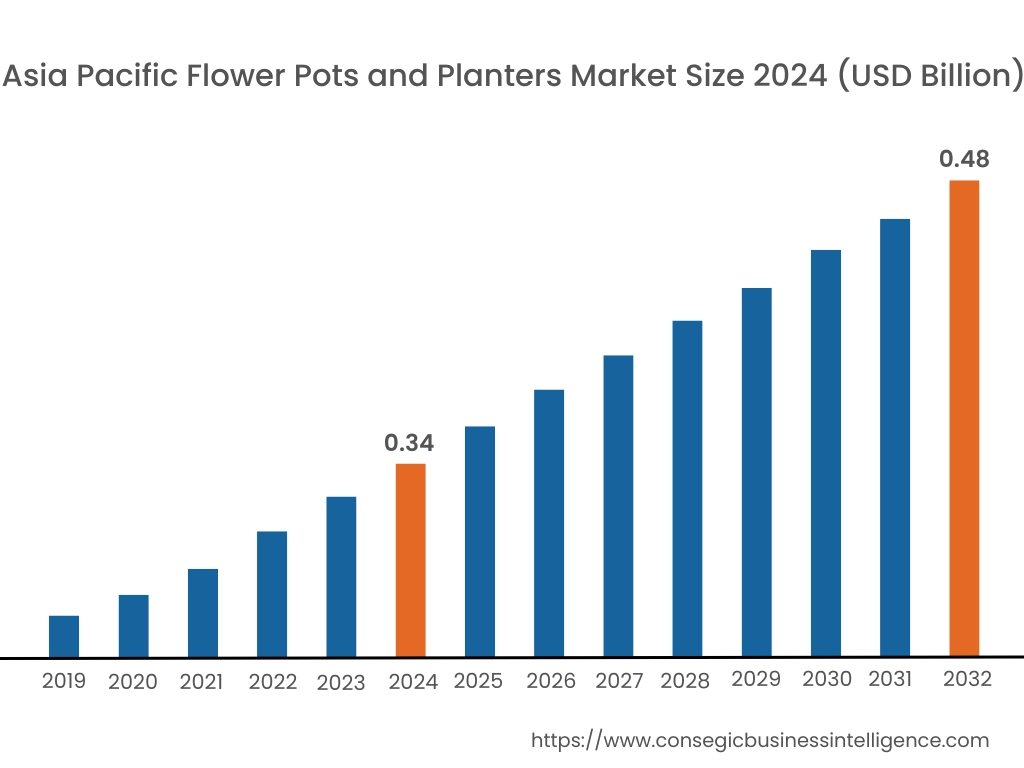
Asia Pacific region was valued at USD 0.34 Billion in 2024. Moreover, it is projected to grow by USD 0.35 Billion in 2025 and reach over USD 0.48 Billion by 2032. Out of this, China accounted for the maximum revenue share of 39.7%.
Rapid urbanization and a growing middle-class gardening culture are fueling adoption of flower pots and planters in Asia-Pacific. China’s residential high-rise developments and India’s terrace-garden initiatives dominate, with interest in Japan and South Korea reflecting a preference for minimalist, space-saving designs. The shifting trend towards modular planter systems that fit varied balcony layouts and the integration of smart sensor kits for soil moisture monitoring have fueled the market progress. Analysis of the market showed that municipal vertical-gardening programs and consumer tech adoption spur product innovation, significantly driving the flower pots and planters market demand.
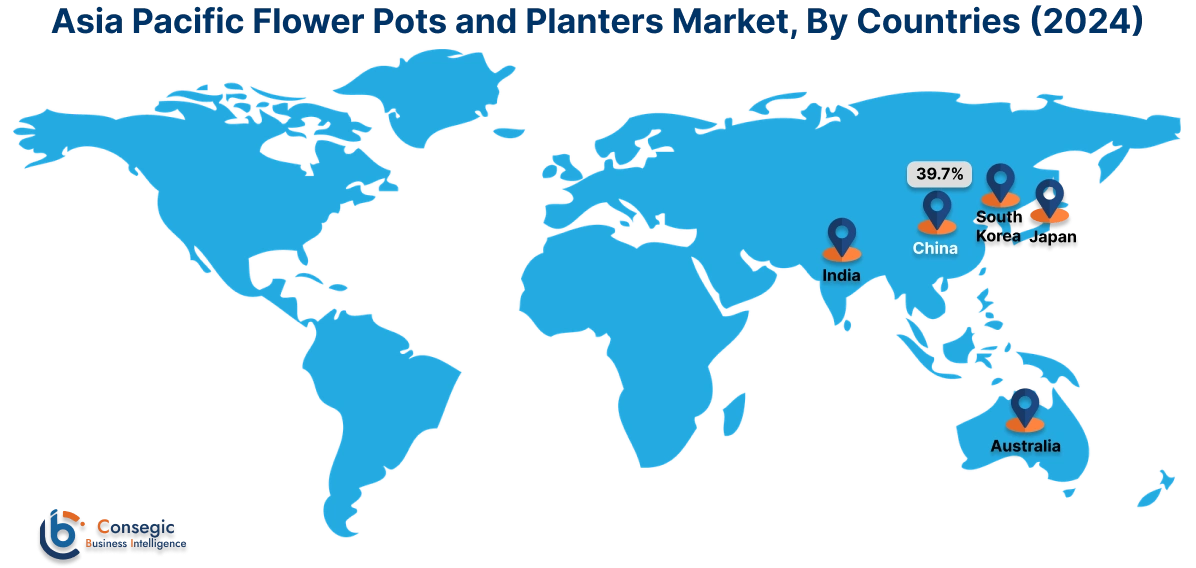
North America is estimated to reach over USD 0.58 Billion by 2032 from a value of USD 0.41 Billion in 2024 and is projected to grow by USD 0.42 Billion in 2025.
Rising interest in urban greening initiatives and home gardening is driving the flower pots and planters market in North America. The United States leads with municipal programs promoting rooftop and balcony gardening, and Canada follows through provincial grants for community gardening spaces. The growing use of lightweight, UV-resistant materials to withstand varied climates, while another trends highlights eco-friendly designs using recycled polymers and bio-based polymers propels market demand. Furthermore, Analysis of the market showed that federal and state-level sustainability incentives are key enablers, significantly driving the flower pots and planters industry in this region.
Stringent environmental regulations and a resurgence of indoor horticulture are reshaping the market across Europe. Germany’s urban greening mandates and France’s public-space beautification schemes set the pace, while the United Kingdom and the Netherlands follow with strong interest in decorative indoor and balcony planting. One trend centers on smart planters with self-watering systems that cater to busy lifestyles, while another trend emphasizes artisanal ceramic and terracotta designs reflecting regional design heritage. Analysis of the market showed that EU urban sustainability programs support supplier innovation, and partnerships among design studios and plant nurseries are driving collections tailored to local tastes, boosting the flower pots and planters market in this region.
Water-efficient landscaping requirements and upscale residential developments are redefining the market in the Middle East & Africa. The United Arab Emirates’ luxury rooftop gardens and South Africa’s eco-friendly public-park initiatives lead, while Morocco and Kenya pursue urban beautification schemes using drought-tolerant plantings. A significant trend centers on textured, heat-reflective finishes that protect root systems propelling market growth. Analysis of the market showed that government-backed green-building standards are critical drivers and the alliances with landscape architects ensure product performance under extreme environmental conditions have fueled the flower pots and planters market in this region.
Growing interest in outdoor entertaining spaces and community-led greening projects is energizing the market in Latin America. Brazil’s residential balcony gardens and Argentina’s public-plaza plant installations lead the way, alongside Chile’s eco-tourism sites that showcase native flora in containerized displays. Additionally, analysis of the market showed that municipal urban-forestry campaigns support local manufacturer networks and collaborations between craft cooperatives and horticultural societies are fostering designs, fueling flower pots and planters market growth in this region.
Top Key Players and Market Share Insights:
The Flower Pots and Planters Market is highly competitive with major players providing products and services to the national and international markets. Key players are adopting several strategies in research and development (R&D), product innovation, and end-user launches to hold a strong position in the global Flower Pots and Planters Market. Key players in the Flower Pots and Planters industry include -
- The HC Companies, Inc. (USA)
- Lechuza (Germany)
- Crescent Garden (USA)
- Mayne Inc. (Canada)
- Tusco Products (USA)
- ELHO (Netherlands)
- Scheurich GmbH & Co. KG (Germany)
- Southern Patio (Ames Companies) (USA)
- East Jordan Plastics (USA)
- Bloem (USA)
Recent Industry Developments :
Product Launches:
- In January 2025, LeafyPod introduced its innovative AI-powered smart planter, designed to simplify indoor plant care by integrating advanced technology with user-friendly features. Developed by former Tesla and Meta engineers, the planter automates watering schedules and monitors environmental conditions such as light, humidity, temperature, and soil moisture through built-in sensors. These real-time insights are accessible via the LeafyPod mobile app, which also allows for voice-controlled interactions through smart home systems like Alexa and Google Assistant.
Flower Pots and Planters Market Report Insights:
| Report Attributes | Report Details |
| Study Timeline | 2019-2032 |
| Market Size in 2032 | USD 1.74 Billion |
| CAGR (2025-2032) | 4.4% |
| By Material Type |
|
| By Application |
|
| By Distribution Channel |
|
| By Region |
|
| Key Players |
|
| North America | U.S. Canada Mexico |
| Europe | U.K. Germany France Spain Italy Russia Benelux Rest of Europe |
| APAC | China South Korea Japan India Australia ASEAN Rest of Asia-Pacific |
| Middle East and Africa | GCC Turkey South Africa Rest of MEA |
| LATAM | Brazil Argentina Chile Rest of LATAM |
| Report Coverage |
|
Key Questions Answered in the Report
How big is the Flower Pots and Planters Market? +
Flower Pots and Planters Market size is estimated to reach over USD 1.74 Billion by 2032 from a value of USD 1.24 Billion in 2024 and is projected to grow by USD 1.27 Billion in 2025, growing at a CAGR of 4.4% from 2025 to 2032.
What specific segments are covered in the Flower Pots and Planters Market? +
The Flower Pots and Planters Market specific segments for Material Type, Application, Distribution Channel, and Region.
Which is the fastest-growing region in the Flower Pots and Planters Market? +
Asia pacific is the fastest growing region in the Flower Pots and Planters Market.
What are the major players in the Flower Pots and Planters Market? +
The key players in the Flower Pots and Planters Market are The HC Companies, Inc. (USA), Lechuza (Germany), ELHO (Netherlands), Scheurich GmbH & Co. KG (Germany), Southern Patio (Ames Companies) (USA), East Jordan Plastics (USA), Bloem (USA), Crescent Garden (USA), Mayne Inc. (Canada), Tusco Products (USA), and others.
